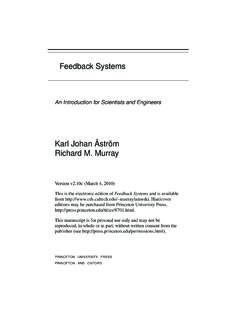Transcription of Linea r Controller Design: Limits of P erfo rmance
1 Linear ControllerDesign:Limitsof PerformanceStephenBoydCraigBarrattOrigin allypublished1991by control Engineering and Controller Design1 OverviewofControlEngineering 1 GoalsofControllerDesign 6 ControlEngineeringandTechnology 9 PurposeofthisBook 11 BookOutline 16 NotesandReferences 18I A FRAMEWORK FOR Controller DESIGN232 A Framework for control system Architecture25 TerminologyandDe nitions 25 Assumptions 28 SomeStandardExamplesfromClassicalControl 34 AStandardNumericalExample 41 AState SpaceFormulation 43 NotesandReferences 453 Controller design Specifications and Approaches47 DesignSpeci cations 47 TheFeasibilityProblem 51 FamiliesofDesignSpeci cations 51 FunctionalInequalitySpeci cations 52 MulticriterionOptimization 54 OptimalControllerParadigm 57 GeneralDesignProcedures 63 NotesandReferences 65 VVICONTENTSII ANALYTICAL TOOLS674 Norms of Signals69 De nition 69 CommonNormsofScalarSignals 70 CommonNormsofVectorSignals 86
2 ComparingNorms 89 NotesandReferences 925 Norms of Systems93 ParadigmsforSystemNorms 93 NormsofSISOLTIS ystems 95 NormsofMIMOLTIS ystems 110 ImportantPropertiesofGains 115 ComparingNorms 117 State SpaceMethodsforComputingNorms 119 NotesandReferences 1246 Geometry of design Specifications127 DesignSpeci cationsasSets 127 A neandConvexSetsandFunctionals 128 Closed LoopConvexDesignSpeci cations 135 SomeExamples 136 ImplicationsforTradeo sandOptimization 138 ConvexityandDuality 139 NotesandReferences 143 III design SPECIFICATIONS1457 Realizability and Closed-Loop Stability147 Realizability 147 InternalStability 150 Modi edControllerParadigm 157 AState SpaceParametrization 162 SomeGeneralizationsofClosed LoopStability 165 NotesandReferences 1688 Performance Specifications171 Input OutputSpeci cations 172 RegulationSpeci cations 187 ActuatorE ort 190 CombinedE ectofDisturbancesandCommands 191 CONTENTSVII9 Differential Sensitivity Specifications195 Bode sLogSensitivities 196 MAMSLogSensitivity 202 GeneralDi erentialSensitivity 204 NotesandReferences 20810 Robustness Specifications via Gain Bounds209 RobustnessSpeci cations 210 ExamplesofRobustnessSpeci cations 212 PerturbationFeedbackForm 221 SmallGainMethodforRobustStability 231 SmallGainMethodforRobustPerformance 239 NotesandReferences 24411 A Pictorial Example249 I OSpeci cations 250 Regulation 254 ActuatorE ort 256 SensitivitySpeci cations 260 RobustnessSpeci cations 262 NonconvexDesignSpeci cations 268 AWeighted MaxFunctional 268 NotesandReferences 270IV NUMERICAL METHODS27312 Some Analytic Solutions275 LinearQuadraticRegulator 275 LinearQuadraticGaussianRegulator 278 MinimumEntropyRegulator 282 ASimpleRiseTime UndershootExample 283 AWeightedPeakTrackingErrorExample 286 NotesandReferences 29113 Elements of Convex Analysis293 Subgradients 293 SupportingHyperplanes 298
3 ToolsforComputingSubgradients 299 ComputingSubgradients 301 SubgradientsonaFinite DimensionalSubspace 307 NotesandReferences 309 VIIICONTENTS14 Special Algorithms for Convex Optimization311 NotationandProblemDe nitions 311 OnAlgorithmsforConvexOptimization 312 Cutting PlaneAlgorithms 313 EllipsoidAlgorithms 324 Example LQGW eightSelectionviaDuality 332 ComplexityofConvexOptimization 345 NotesandReferences 34815 Solving the Controller design Problem351 RitzApproximations 352 AnExamplewithanAnalyticSolution 354 AnExamplewithnoAnalyticSolution 355 AnOuterApproximationviaDuality 362 SomeTradeo Curves 366 NotesandReferences 36916 Discussion and Conclusions373 TheMainPoints 373 ControlEngineeringRevisited 373 SomeHistoryoftheMainIdeas 377 SomeExtensions 380 Notation and Symbols383 List of Acronyms389 Bibliography391 Index405 PrefaceThisbookismotivatedbythefollowing technologicaldevelopments highqualityintegratedsensorsandactuators powerfulcontrolprocessorsthatcanimplemen tcomplexcontrolalgorithms andpowerfulcomputerhardwareandsoftwareth atcanbeusedtodesignandanalyzecontrolsyst ems Webelievethatthesetechnologicaldevelopme ntshavethefollowingrami cationsforlinearcontrollerdesign Whenmanyhighqualitysensorsandactuatorsar eincorporatedintothede signofasystem sophisticatedcontrolalgorithmscanoutperf ormthesimplecontrolalgorithmsthathavesu cedinthepast Currentmethodsofcomputer aidedcontrolsystemdesignunderutilizeavai l ablecomputingpowerandneedtoberethought Thisbookisonesmallstepinthedirectionssug gestedbytheserami cations Wehaveseveralgoalsinwritingthistext Togiveacleardescriptionofhowwemightformu latethelinearcontrollerdesignproblem withoutregardforhowwemayactuallysolveit modelingfundamentalspeci cationsasopposedtospeci cationsthatareartifactsofaparticularmeth odusedtosolvethedesignproblem Toshowthatawide butincomplete
4 Classoflinearcontrollerdesignproblemscan becastasconvexoptimizationproblems Toarguethatsolvingthecontrollerdesignpro blemsinthisrestrictedclassisinsomesensef undamentallytractable althoughitinvolvesmorecomputingthanthest andardmethodsthathave analytical solutions itinvolvesmuchlesscomputingthanaglobalpa rametersearch Thisprovidesapartialanswertothequestiono fhowtouseavailablecomputingpowertodesign controllers IXXPREFACE Toemphasizeanaspectoflinearcontrollerdes ignthathasnotbeenempha sizedinthepast thedeterminationoflimitsofperformance i e speci ca tionsthatcannotbeachievedwithagivensyste mandcontrolcon guration Itisnotourgoaltosurveyrecentlydevelopedt echniquesoflinearcontrollerdesign orto directly teachthereaderhowtodesignlinearcontrolle rs severalexistingtextsdoagoodjobofthat Ontheotherhand aclearformulationofthelinearcontrollerde signproblem andanunderstandingthatmanyoftheperforman celimitsofalinearcontrolsystemcanbecompu ted areusefultothepracticingcontrolengineer Ourintendedaudienceincludesthesophistica tedindustrialcontrolengineer andresearchersandresearchstudentsincontr olengineering Weassumethereaderhasabasicknowledgeoflin earsystems Kailath Kai Chen Che ZadehandDesoer ZD Althoughitisnotaprerequisite thereaderwillbene tfromapriorexposuretolinearcontrolsystem s fromboththe classical and modern orstate spacepointsofview Byclassicalcontrolwerefertotopicssuchasr ootlocus Bodeplots PIandlead lagcontrollers Ogata Oga Franklin Powell Emami FPE Bystate spacecontrolwemeanthethe oryanduseofthelinearquadraticregulator LQR Kalman lter andlinearquadraticGaussian LQG Controller AndersonandMoore AM KwakernaakandSivan KS BrysonandHo BH Wehavetriedtomaintainaninformal ratherthancompletelyrigorous approachtothemathematicsinthisbook Forexample inchapter weconsiderlinearfunctionalsonin nite dimensionalspaces butwedonotusethetermdualspace
5 Andweavoidanydiscussionoftheircontinuity properties Wehavegivenproofsandderivationsonlywhent heyaresimpleandinstructive Thereferenceswecitecon tainprecisestatements carefulderivations moregeneralformulations andproofs Wehaveadoptedthisapproachbecausewebeliev ethatmanyofthebasicideasareaccessibletot hosewithoutastrongmathematicsbackground andthosewiththebackgroundcansupplythenec essaryquali cations guessvariousgeneralizations orrecognizetermsthatwehavenotused ANotesandReferencessectionappearsattheen dofeachchapter Wehavenotattemptedtogiveacompletebibliog raphy rather wehavecitedafewkeyreferencesforeachtopic Weapologizetothemanyresearchersandauthor swhoserelevantwork especially workinlanguagesotherthanEnglish wehavenotcited Thereaderwhowishestocompileamorecomplete setofreferencescanstartbycomputingthetra nsitiveclosureofours i e ourreferencesalongwiththereferencesinour references andsoon PREFACEXIOur rstacknowledgmentistoProfessorC Desoer whointroducedtheideaoftheQ parametrization alongwiththeadvice thisisgoodforCAD toStephenBoydinEECS BatBerkeleyin Wethankthereviewers ProfessorC Desoer ProfessorP Kokotovic ProfessorL Ljung Dr M WorkmanofIBM andDr R KosutofIntegratedSystems Inc forvaluablesuggestions WeareverygratefultoProfessorT Higginsforextensivecommentsonthehistorya ndliteratureofcontrolengineering andathoroughreadingofourmanuscript WethankS Norman acoauthorofthepaper BBN fromwhichthisbookwasdeveloped andV Balakrishnan N Boyd X Li C Oakley D Pettibone A Ranieri andQ Yangfornumerouscommentsandsuggestions Duringtheresearchforandwritingofthisbook theauthorshavebeensup portedbytheNationalScienceFoundation ECS theO ceofNavalResearch N K andtheAirForceO ceofScienti cResearch StephenBoydStanford CaliforniaCraigBarrattMay ThisbookwastypesetbytheauthorsusingLaTEX Thesimulations numericalcom putations and guresweredevelopedinmatlabandc
6 Undertheunixoperatingsystem Weencouragereaderstoattempttoreproduceou rplotsand gures andwouldappreciatehearingaboutanyerrors XIIPREFACEC hapter 1 control Engineering andController DesignControllerdesign thetopicofthisbook isonlyapartofthebroadertaskofcontrolengi neering Inthischapterwe rstgiveabriefoverviewofcontrolengineerin g withthegoalofdescribingthecontextofcontr ollerdesign Wethengiveageneraldiscussionofthegoalsof controllerdesign and nallyanoutlineofthisbook Overview of control EngineeringThegoalofcontrolengineeringis toimprove orinsomecasesenable theperfor manceofasystembytheadditionofsensors controlprocessors andactuators Thesensorsmeasureorsensevarioussignalsin thesystemandoperatorcommands thecontrolprocessorsprocessthesensedsign alsanddrivetheactuators whicha ectthebehaviorofthesystem Aschematicdiagramofageneralcontrolsystem isshownin gure Thisgeneraldiagramcanrepresentawidevarie tyofcontrolsystems Thesys temtobecontrolledmightbeanaircraft alargeelectricpowergenerationanddistribu tionsystem anindustrialprocess aheadpositionerforacomputerdiskdrive adatanetwork oraneconomicsystem Thesignalsmightbetransmittedviaanalogord igitallyencodedelectricalsignals mechanicallinkages orpneumaticorhydrauliclines Similarlythecontrolprocessororprocessors couldbemechanical pneumatic hydraulic analogelectrical general purposeorcustomdigitalcomput ers Becausethesensorsignalscana ectthesystemtobecontrolled viathecon trolprocessorandtheactuators thecontrolsystemshownin gure iscalled12 CHAPTER1 CONTROLENGINEERING ANDCONTROLLERDESIGNS ystemtobecontrolledControlprocessor s actuatorsignalssensedsignalsactuatorssen sorsoperatordisplay warningindicatorscommandsignals operatorinputs othersignalsthata ectsystem disturbances ssss Figure Aschematicdiagramofageneralcontrolsystem afeedbackorclosed loopcontrolsystem whichreferstothesignal loop thatcir
7 Culatesclockwiseinthis gure Incontrast acontrolsystemthathasnosensors andthereforegeneratestheactuatorsignalsf romthecommandsignalsalone issometimescalledanopen loopcontrolsystem Similarly acontrolsystemthathasnoactuators andproducesonlyoperatordisplaysignalsbyp rocessingthesensorsignals issometimescalledamonitoringsystem Inindustrialsettings itisoftenthecasethatthesensor actuator andprocessorsignalsareboolean i e assumeonlytwovalues Booleansensorsincludemechan icalandthermallimitswitches proximityswitches thermostats andpushbuttonswitchesforoperatorcommands Actuatorsthatareoftencon guredasbooleandevicesincludeheaters motors pumps valves solenoids alarms andindicatorlamps Booleancontrolprocessors referredtoaslogiccontrollers includeindus trialrelaysystems general purposemicroprocessors andcommercialprogrammablelogiccontroller s Inthisbook weconsidercontrolsystemsinwhichthesensor actuator andprocessorsignalsassumerealvalues oratleastdigitalrepresentationsofrealval ues Manycontrolsystemsincludebothtypesofsign als thereal valuedsignalsthatwewillconsider andbooleansignals suchasfaultorlimitalarmsandmanualoverrid eswitches thatwewillnotconsider OVERVIEW OFCONTROLENGINEERING3 Incontrolsystemsthatusedigitalcomputersa scontrolprocessors thesignalsaresampledatregularintervals whichmaydi erfordi erentsignals Insomecasestheseintervalsareshortenought hatthesampledsignalsaregoodapproximation softhecontinuoussignals butinmanycasesthee ectsofthissamplingmustbeconsideredinthed esignofthecontrolsystem Inthisbook weconsidercontrolsystemsinwhichallsignal sarecontinuousfunctionsoftime Inthenextfewsubsectionswebrie ydescribesomeoftheimportanttasksthatmake upcontrolengineering system design and control ConfigurationControlcon gurationistheselectionandplacementofthea ctuatorsandsensorsonthesystemtobecontrol led
8 Andisanaspectofsystemdesignthatisveryimp ortanttothecontrolengineer Ideally acontrolengineershouldbeinvolvedinthedes ignofthesystemitself evenbeforethecontrolcon guration Usually however thisisnotthecase thecontrolengineerisprovidedwithanalread ydesignedsystemandstartswiththecontrolco n guration Manyaircraft forexample aredesignedtooperatewithoutacontrolsyste m thecontrolsystemisintendedtoimprovethepe rformance indeed suchcontrolsystemsaresometimescalledstab ilityaugmentationsystems emphasizingthesecondaryroleofthecontrols ystem Actuator Selection and PlacementThecontrolengineermustdecidethe typeandplacementoftheactuators Inanindustrialprocesssystem forexample theengineermustdecidewheretoputactuators suchaspumps heaters andvalves Thespeci cactuatorhardware oratleast itsrelevantcharacteristics mustalsobechosen Relevantcharacteristicsincludecost powerlimitorauthority speedofresponse andaccuracyofresponse Onesuchchoicemightbebetweenacrude powerfulpumpthatisslowtorespond andamoreaccuratebutlesspowerfulpumpthati sfastertorespond Sensor Selection and PlacementThecontrolengineermustalsodecid ewhichsignalsinthesystemwillbemeasuredor sensed andwithwhatsensorhardware Inanindustrialprocess forexample thecontrolengineermightdecidewhichtemper atures owrates pressures andconcentrationstosense Foramechanicalsystem itmaybepossibletochoosewhereasensorshoul dbeplaced e g whereanaccelerometeristobepositionedonan aircraft orwhereastraingaugeisplacedalongabeam Thecontrolengineermaydecidetheparticular typeorrelevantcharacteristicsofthesensor stobeused includingthetypeoftransducer andthesignalconditioninganddataacquisiti onhardware Forexample tomeasuretheangleofashaft sensorchoicesincludeapotentiometer arotaryvariabledi erentialtransformer oran bitor bit4 CHAPTER1 CONTROLENGINEERING ANDCONTROLLERDESIGN absoluteordi erentialshaftencoder Inmanycases
9 Sensorsaresmallerthanactuators soachangeofsensorhardwareisalessdramatic revisionofthesystemdesignthanachangeofac tuatorhardware Thereisnotyetawell developedtheoryofactuatorandsensorselect ionandplacement possiblybec



















